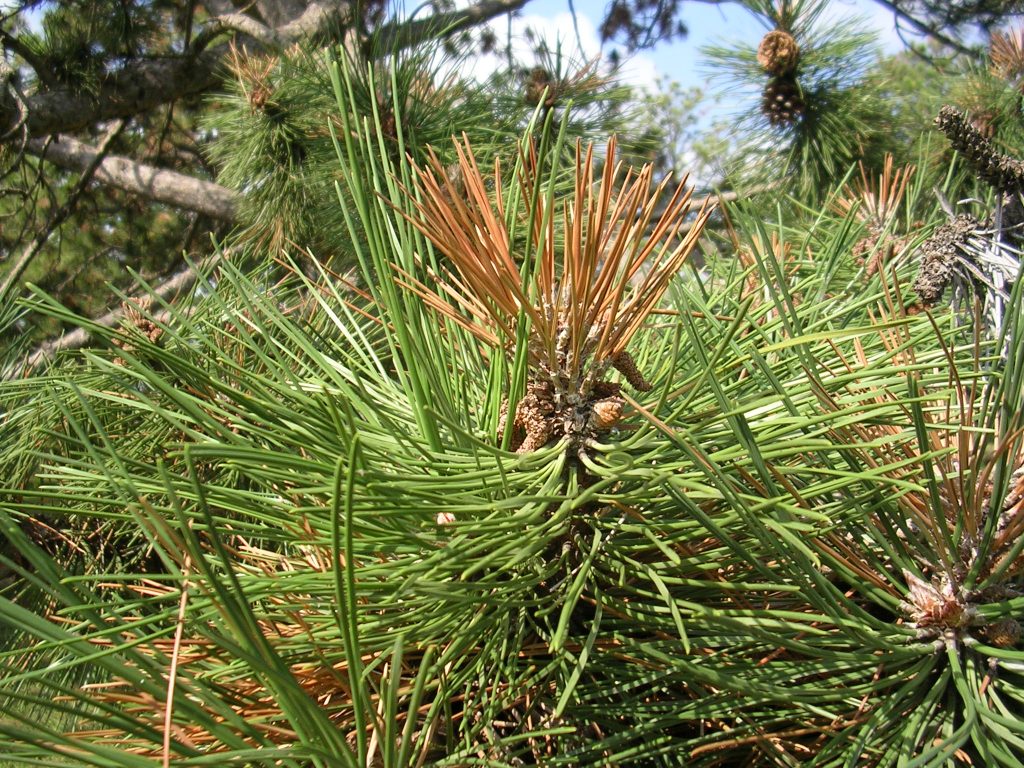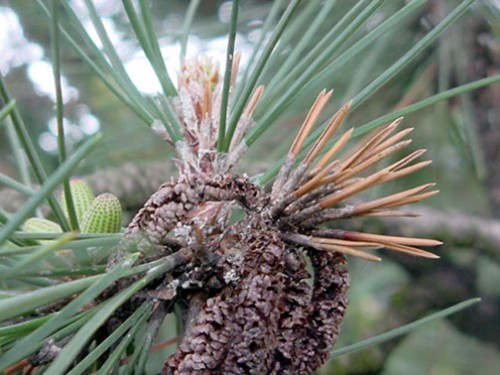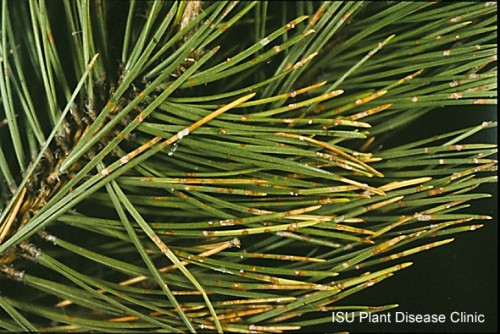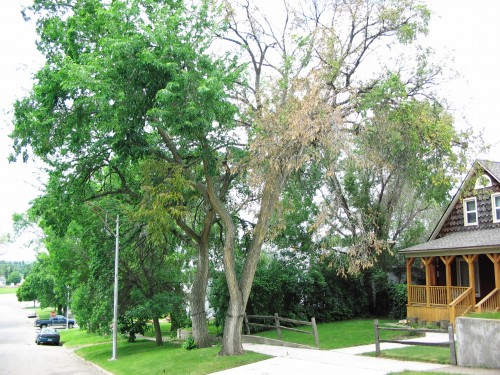
Diseases
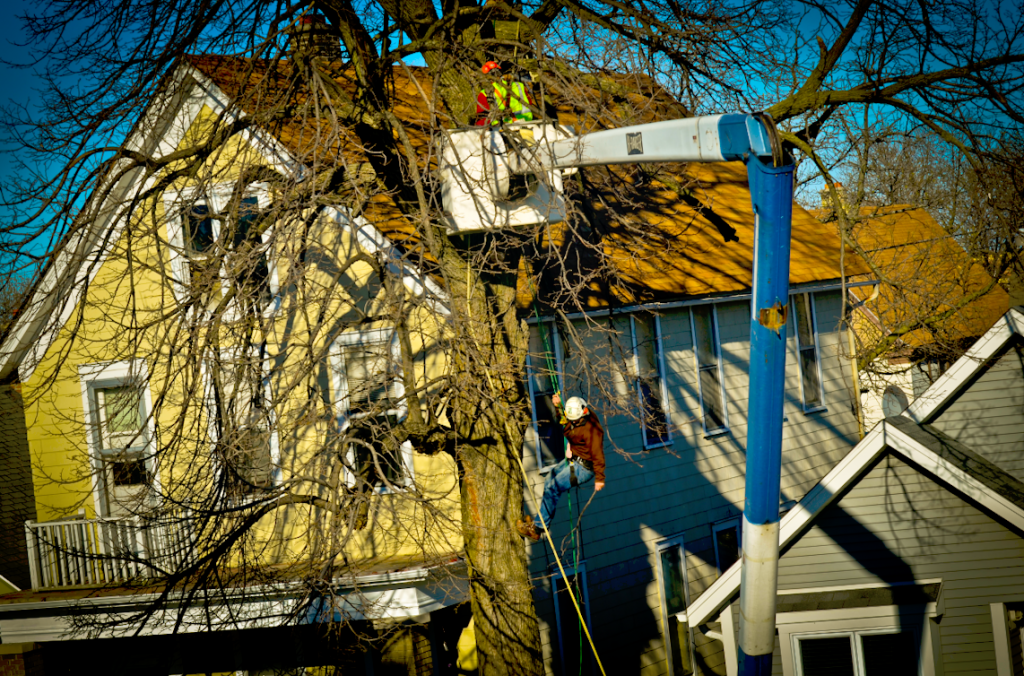
Anthracnose is one of the most prominent unsightly diseases of shade trees. It is a foliar disease caused by different species of fungi. The disease is most active in the spring and can become quite severe if cooler wet weather persists in spring. as Due to the progression of the disease into stem and bud tissue, some trees like sycamore and dogwood are more inclined to be adversely affected by anthracnose.
Affected trees: ash, oak, dogwood, elm, hickory, walnut, maple, and sycamore.
Noticeable Signs
Common signs of anthracnose tend to show:
- Tan to brown or black blotchy areas along the leaf veins.
- Infected areas will expand outwards towards the leaf margin, causing irregular brown patches that distort the leaf.
- Tiny fungal spore masses can be seen on the underside of infected leaves through a magnified lens.
- Compromised leaves are more noticeable on lower branches.
- Younger leaves may die and fall after initial infection, but re-leaf by summer.
- Cankers can be seen on stems and branches of severely infected hosts.
Treatment/ Management
Anthracnose can be managed through proper ground sanitation of leaves and branches in the fall. Pruning cankers (localized injuries) from infected stems and branches back to healthy laterals can stop or slow the progression of the disease.
Depending on the severity of the Anthracnose, along with the cultural practices described above, we would recommend a 3-application foliar Fungicidal spray program beginning in the spring when the buds first appear along with two additional sprays at 10-14 day intervals.
Apple Scab
Apple-scab, Venturia inaequalis, is a fungal disease that affects leaves, fruit, and twigs of edible and ornamental crabapples, mountain ash, cotoneaster, pear, and hawthorn apples as well. Apple scab can diminish the aesthetic quality of an apple tree by early defoliation and unsightly blemishes on leaves and fruit. In some cases, branch dieback can occur as the disease progresses. The disease rarely kills, but it can severely affect the health of the tree by reducing growth, vigor, and fruit production. Repeated infections can weaken the tree and make it a susceptible host to other diseases and or pests.
Noticeable Signs
Common signs of Apple scab tend to show:
- Brown to olive lesions on leaves in late spring eventually turning black.
- Heavily infected leaves turn yellow and then defoliate.
- Fruit can also display similar symptoms as to those on leaves.
- Lesions on fruit will unevenly mature, crack, and turn brown and corky.
Treatment/Management
Reducing the chance of infection can be accomplished by raking and proper disposal of leaves in fall, watering at ground level, and proper pruning for better air circulation.
Two to three fungicidal spray applications in the spring, starting at bud break and continuing can also produce positive results. If wetter conditions exist a fourth spray may be necessary.
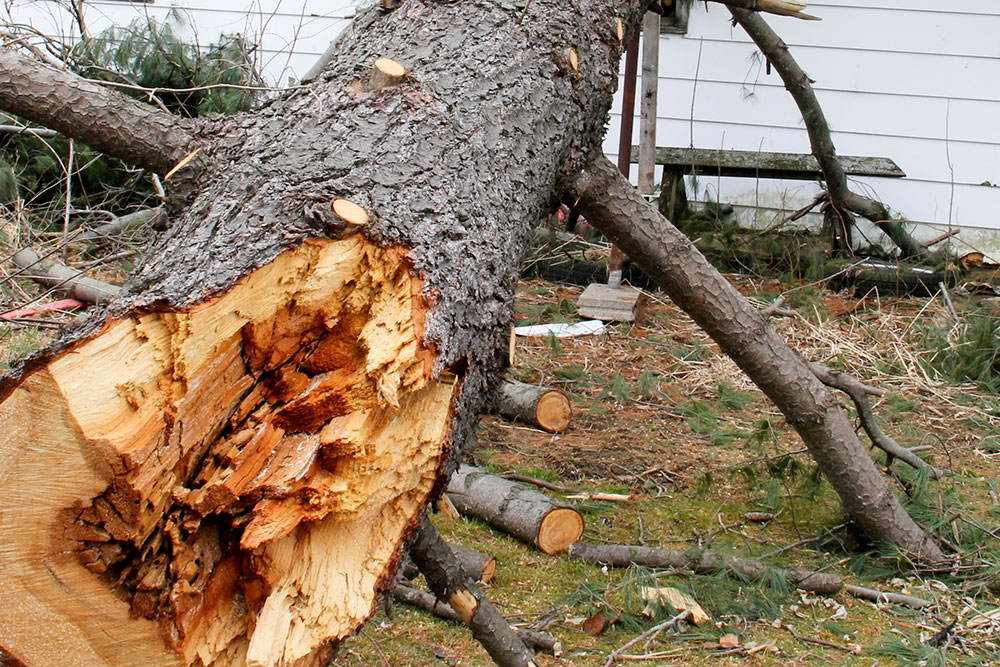
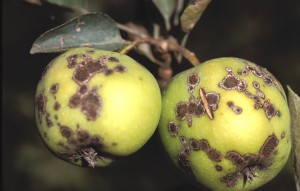
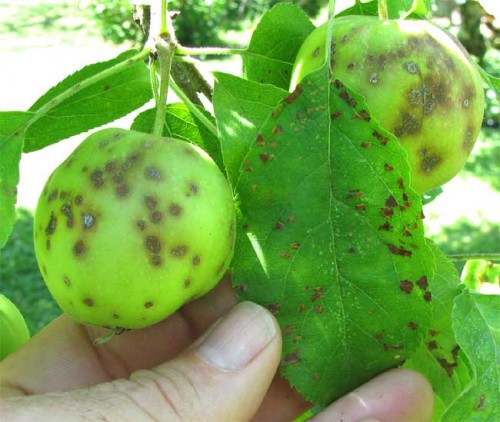

Diplodia Pine Shoot Blight
Diplodia is caused by the fungus Diplodia pinea and survives in new growth, branches, and if left untreated can infect the main truck itself. . This pathogen commonly affects mature trees that have been stressed as a result drought, pollution, soil compaction, water competition, and other planting site related issues. Repeated infections can stunt growth, deform, and eventually lead to total tree decline.
Affected trees: red, Austrian, scots, mugo, white, and ponderosa pine; spruce and douglas fir can also be affected.
Noticeable Signs
Common signs of Diplodia tend to show:
- As new needles emerge they tend to turn yellow, then brown, and eventually die back towards the branch.
- Black fruiting bodies can be seen on cones or at the base of the needles.
- If left untreated the disease can infect the branches or the main stem; thus turning into a canker phase that creates wounds and can ooze sap.
Treatment/ Management
It is very important to maintain a treatment plan for Diplodia, as there is no cure for this disease. We recommend an annual fungicidal spray program that consists of two sprays in late spring; the first being right when the new growth emerges and the second approximately 21 days after.
Dothistroma Pine Needle Blight
One of the most common fungal diseases to affect pines is dothistroma. This disease affects over thirty species of pine trees and is responsible for much of the premature needle drop associated with urban pine. This disease can kill younger hosts; older trees will continuously defoliate and eventually lose their aesthetic value
Affected trees: Austrian pine, ponderosa pine, mugo pine, and scotts pine in some rare cases.
Noticeable signs
Common signs of dothistroma tend to show:
- Scattered spots begin in fall but are barely noticeable
- Older needles vary in color from yellow to red, eventually turning brown by mid-summer to fall
- Spots often develop into red bands that encircle the needles, turning brown and then dying towards the tip while the base remains green
- After the needles die, black fruiting structures appear on the outer needle tissue.
- Infections will cause premature needle drop, typically in lower branches first.
Treatment/Management
Two to three fungicidal spray applications in spring, starting at the bud and continuing every 3 to 4 week intervals. The first spray protects older growth while the second and or third protects new growth. Treatment for dothistroma will not cure the disease, but it will stop the progression of it.


Dutch Elm Disease
Dutch Elm Disease (DED) is a fatal disease caused by a vascular wilt fungus, Ophiostoma novo-ulmi. The disease was initially introduced to the United States in the 1930’s, killing millions of elm trees, and to this day remains the most devastating shade tree disease in North America.
Dutch Elm Disease (DED) can be transmitted by way of a root graph between trees 50’ or less, but is most commonly vectored from a diseased tree to a healthy one by either the European Elm Bark Beetle or the native Elm Bark Beetle. 2-3 generations of Elm Bark Beetles reproduce every year, spreading the fungal spores to healthy trees by feeding on 2-4 year old branches. It takes 4-6 weeks after initial infection to show symptoms of Dutch Elms Disease (DED). Upon infection the fungus blocks the vascular system preventing water and minerals from reaching branches and leaves.
To determine Dutch Elm Disease (DED) progression, branches will dye followed by major limbs, and then ultimately tree death. In rare circumstances, Dutch Elm Disease (DED) resistance is found in younger elm trees, allowing a lifespan of 15-20 years; this also can be seen in older specimens, nevertheless, one can only expect the tree to live 1-2 years after initial infection.
Noticeable Signs
Common signs of Dutch Elm Disease tend to show:
- Intermittent wilting of leaves on branches throughout the upper canopy, not to be confused with mechanical symptoms due to drought that can also cause a flagging effect throughout the entire canopy.
- If the transmittal is from a root graph, flagging may be on lower branches nearest root graph. This is followed by a change in leaf color from green to yellow to brown, then finally shriveling up and dying.
- It is simply not enough to base a determination of Dutch Elm Disease (DED) on flagging or leaf color change; to be certain a certified arborist should perform a consultation and peel the bark back to expose discoloration of the vascular system. This is followed by a brown discoloration of the diseased specimen along the water-conducting vessels (xylem) of the wood.
Treatment/ Management
Most Dutch Elm Disease (DED) infected trees can’t be saved; however, if caught early enough sanitizing infected areas of the tree through proper pruning along with a fungicide, cannot only save the tree, but also protect it from future infestation. We recommend a macro-infused fungicidal trunk injection on the diseased elm with a product called Arbortech 20-S which provides 99.5% protection from Dutch Elm Disease for three growing seasons.
Rhizosphera Needle Cast
Rhizosphera Needle Cast, Rhizosphera kalkhoffi is a fungal disease that affects the foliage of spruce trees. It is perhaps the most common needle disease affecting spruce trees in Wisconsin. Trees that are stressed from drought and mechanical factors, such as poor planting practices and improper fertilization tend to be more likely to suffer from Rhizosphaera needle cast.
Affected trees: Colorado blue spruce, Picea pungens, happen to be highly susceptible to this disease, while white spruce (including Black Hills spruce), P. glauca, is intermediate in susceptibility, and Norway spruce, P. abies, is relatively resistant.
Noticeable signs
Common signs of rhizosphera tend to show:
- Older, inner, needles show symptoms first, followed by newer growth as the disease progresses.
- Needles will appear modeled with dull yellow blotches, later turning brown.
- Black spots can be seen through a magnified glass in the stomata on the underside of the needles.
- Infected branches will exhibit noticeable signs of branch thinning, especially on the lower canopy and move upward as the disease progresses.
- Needle cast (drop) can happen anywhere from 3-15 months after infection, depending on the species.
Treatment/Management
Reduced moisture along with increased airflow through proper pruning will help control the progression Rhizosphera Needle Cast. Proper sanitation of dropped needles can generate a healthier tree.
We suggest a two application fungicidal spray program beginning just after the new growth emerges and the second spray roughly three weeks later.
